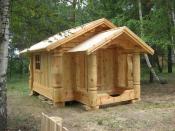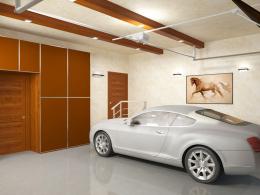Search
Login
Recommended
Finishing a garage, how to, than decorating a garage inside, options
A garage is a building belonging to the category of objects with an increased risk of fire and a high probability of explosions. When deciding on building materials for finishing work, you need to remember these factors. In this room, even with the most careful use, from time to time the formation of chemical vapors occurs (evaporation of fuels and lubricants, industrial oil, asphalt chemicals, and so on). In addition, the coating on the walls may be damaged during automobile maneuvers or inadvertent use of metal tools.
Content
- Garage Interior Material Requirements
- Finishing the garage inside with stucco video
- Putty finishing for exterior use
- How to sheathe the garage from the inside
- Exterior finish
Garage Interior Material Requirements

Based on this, we can conclude that the materials for the interior decoration of the garage should be:
- fire resistant
- do not deform under the influence of chemically active substances
- do not absorb various odors
- easy to wash
- strong enough.
Finishing the garage inside with stucco

One of the most common and relatively cheap finishing methods is plastering followed by painting. Plaster applied in several layers will perfectly smooth out all the irregularities of the brickwork. In addition to this, the plaster forms an additional layer of waterproofing from humidity and cold. Cement and lime solutions are considered fire-fighting and have the ability to not absorb odors.

Plaster can be applied on surfaces of any kind. But some of them make sense in advance to prepare. The preparation is as follows: cleaning the surface of unnecessary fragments of cement and other contaminants, and then moisturizing with a spray bottle or brush. On a smooth surface of aerated concrete blocks or silicate brick, notches are made with a metal brush. This procedure contributes to the best adhesion of the solution.
Plastering the walls in the garage is mandatory in several layers. In order for the mass in the layers to be distributed evenly, the so-called beacons are fixed and the reference thread is pulled.
The most preferred materials for finishing garage walls are cement mortars. Such a finish will create the most durable hermetic crust. Such a mixture is prepared as follows: 1: 4, where 1 is the cement part, 4 is the sand part.
In the presence of certain financial opportunities, you can use finishing materials that contain granite or marble chips. Such mixtures are also called stone plasters.
Putty finishing for exterior use
Knowing what aggressive impact the room will be exposed to, experts advise using mixtures for painting or hard putty, both inside and out. designed for facade work. Facade materials are made using special technologies that make it possible to withstand both severe frosts and high humidity.

If you want to maximize the service life of the filler coating, a layer of water-repellent paint is applied on top. The layer of this particular paint will facilitate cleaning and will not be a problem with washing the walls.

Also in specialized stores you can buy organosilicon, isoprene or rubber paints. You can apply them on any kind of surface: all types of putty, concrete, brick wall.

Coating the surface with these types of paints gives an excellent layer of waterproofing. The only drawback to using them is the long, painstaking application process. They need to be applied in several layers and each subsequent layer only after the previous one dries.
How to sheathe the garage from the inside
ceramic tiling

The method of cladding with ceramic tiles is quite common. Caring for her is quite simple. It is refractory, very rarely deformed by mechanical damage and is not afraid of chemical compounds. If the gluing process was done strictly according to the instructions, then humidity and water are not an obstacle for it either.
clinker brick or tile
This material is produced as follows: the clay is pressed and burned, so the material has a high degree of strength and fire resistance. As a coating, it can be safely used in rooms with no heating system. In the process of firing, its pores are tightly closed and, as a result, can neither absorb nor pass moisture. Clinker materials are not susceptible to the effects of low temperatures and chemical formations.

Professionally laid ceramic tiles with beautifully designed seams give the room a sleek look. But here there are some drawbacks: the gluing process is even more complicated and painstaking than working with plaster, and the cost of the material itself, in relation to the price of the plaster, will not please.
As for clinker, there are also problems here: the material is heavy and it can only be placed on a concrete or brick wall.
wood paneling
This decor option is relatively cheap, making it possible to create a beautiful finish in the room in the shortest possible time and with minimal pollution of the room. Having certain minimal wood skills, such natural beauty can be done independently without the help of professionals or helpers.

But it is worth noting the fact that wooden cladding is rarely used in a garage. Everything is due to the fact that the tree:
- moody material
- absorbing moisture and deforming from it,
- subject to rotting processes,
- flammable
- absorbing various odors.
Those who dare to make a wooden finish in their garage, will have to periodically cover the material with various protective equipment and impregnations in order to protect themselves from insects, dampness, humidity and be protected from fire.
There is an analogue of wooden decor - these are oriented particle boards. They do not have all the flaws inherent in a tree. They are made of wood chips, and fastened with a special waterproof resin. Therefore, such panels will not allow moisture to pass through, burn and insects will not feed on them. There are no voids in the structure of such panels, so you can safely drive screws and nails into them.
plastic panel trim
PVC coating or lining is a good, non-flammable alternative to wood. Caring for them is much easier. Install plastic trim on the crate, which is mounted at a certain distance from the wall. As a result: a decrease in the usable area of \u200b\u200bthe room.

It is better to use plastic designed for facade finishes. It is less subject to environmental influences and therefore has a longer service life.
The main disadvantage of plastic material is its fragility. In case of careless handling, cracks and dents form. After damaging, to maintain an aesthetic appearance, the damaged part must be replaced.
PVC lining is considered to be the best option for warming an iron box. Insulation sheets are placed between the crate and the wall.

When deciding how to make the cladding of garage walls from the inside, it is first of all worth paying attention to the strength of the material. It is worth remembering that each owner has a lot of useful and necessary things in the garage: various construction and gardening equipment, car parts, and so on. They are mainly located on the walls. Hence the conclusion: the material used for sheathing must withstand the shelves, hangers, hooks, racks attached to it with things laid on them and at the same time not crack, not deform and not break.
Exterior finish
When choosing material for external wall cladding, owners need to remember that cinder concrete and aerated concrete require external insulation, steam and waterproofing. For the outer casing of such a base, sheet materials will be the best option.

It will be most appropriate to use polyvinyl chloride panels. They do not change color under the influence of sunlight and makes the design more accurate and finished in appearance.
When the garage is built of brick or concrete and the walls have a thickness that does not require additional insulation, you can do jointing and plastering.

For external wall cladding with natural stone or decorative brick, not a small amount of money and a long labor-intensive process will be required. But on the other hand, the result will be worth it.





